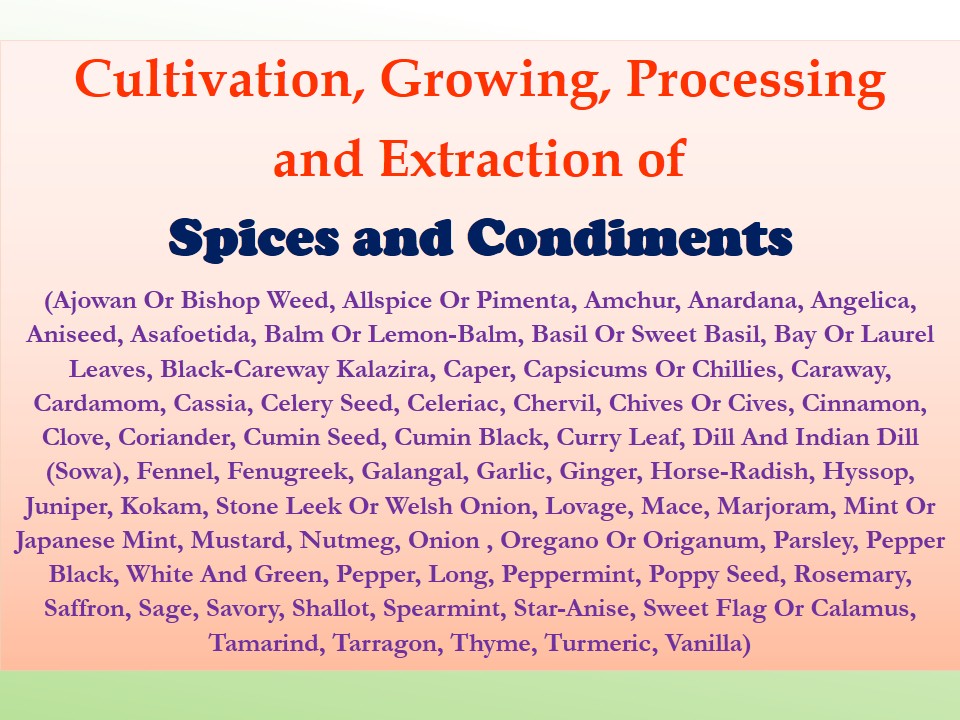
Spices & condiments have always played an important role in the culinary and medicinal world. India is among the largest producers and exporters of these valuable ingredients. From ancient Ayurvedic practices to modern-day exports, these aromatic additions continue to influence economies and health traditions. Their global demand creates opportunities in agriculture, processing, and product innovation.
Cultivation of Spices & Condiments: A Foundation for Success
The journey of spices & condiments begins on the farm. Favorable climatic conditions and fertile soil are essential for quality produce. In India, states like Kerala, Tamil Nadu, Andhra Pradesh, and Karnataka are known for cultivating pepper, cardamom, turmeric, ginger, and clove.
Proper spacing, organic manure, and pest control help increase yield. For instance, turmeric rhizomes are sown during early monsoon and harvested after 7–9 months. Shade and irrigation play a crucial role in crops like cardamom. Disease-resistant seeds must be selected to maintain quality.
With the growth in organic food trends, natural cultivation methods are being preferred. Organic farming has been adopted widely. This not only benefits the soil but also increases market value.
See Also –Citrus Oil Extraction
Training in modern agricultural techniques is offered by government institutions and Krishi Vigyan Kendras. Support through subsidies and minimum support price (MSP) gives a boost to farmers.
Key Points:
-
Climatic suitability ensures better output
-
Disease-resistant seeds are vital for sustainable farming
-
Organic farming enhances export value
Popular Crops:
-
Turmeric
-
Black Pepper
-
Cardamom
-
Ginger
-
Cumin
-
Cloves
These spices & condiments offer varied health benefits. They are used in home remedies, beauty treatments, and food preservation. Because of these qualities, their global export value remains high.
Post-Harvest Processing Techniques
After cultivation, the next step is processing. This stage decides the final quality and shelf life. Proper processing methods retain the aroma, color, and medicinal value.
Curing, drying, cleaning, and grading are some major post-harvest activities. In turmeric, rhizomes are boiled and sun-dried. Similarly, cardamom pods are dried in controlled temperature dryers to maintain their green color.
Manual as well as machine grading is done to separate high and low-quality products. Packaging in moisture-proof materials prevents spoilage. Fumigation or irradiation methods are also used in large-scale operations.
The use of modern dryers and machines helps save time and labor. Vacuum packaging and nitrogen flushing have become popular among exporters. These methods help maintain freshness during transportation.
Advantages of Modern Processing:
-
Improves quality
-
Reduces microbial contamination
-
Increases export potential
In addition, training in hygiene and handling practices helps maintain food safety. Government-approved processing units are eligible for export licenses.
Extraction of Essential Oils and Oleoresins
Spices & condiments are process further to extract essential oils and oleoresins. These extracts are used in food, pharmaceuticals, cosmetics, and perfumery industries. The demand for pure and natural extracts is growing rapidly.
Steam distillation and solvent extraction are the most common methods. For example, clove oil is extract using steam distillation. It is used for its antiseptic and flavoring properties.
Oleoresins are concentrate forms of spices. They offer a longer shelf life and uniform flavor. Turmeric oleoresin is used widely in food coloring and pharmaceuticals.
Extraction requires skill technicians, laboratory equipment, and safety standards. Plants involve in extraction must comply with food-grade norms. Small entrepreneurs can also tie up with contract extraction facilities.
Applications of Extracts:
-
Clove oil – dental care, cosmetics
-
Turmeric oleoresin – health supplements
-
Pepper oil – muscle pain relief
-
Cardamom oil – flavoring in beverages
The value addition through extraction offers high margins. This segment is suitable for startups looking for low-volume, high-value production.
Marketing and Export Potential
Spices & condiments from India are export to more than 150 countries. The USA, UAE, China, and Germany are major importers. Organic and certifie products fetch better prices.
Registration under Spices Board India helps businesses access international markets. The board provides testing, branding, and financial assistance. Participation in international expos helps build buyer networks.
Online platforms like Amazon, Flipkart, and global B2B portals support small sellers. They can now reach overseas customers without owning physical stores. Digital packaging and storytelling around origin and purity add value.
Farmers and processors can form FPOs (Farmer Producer Organizations). These groups allow bulk selling and better negotiation with buyers.
Export Checklist:
-
Product certification (ISO, HACCP, USDA Organic)
-
Labeling in local language for export country
-
Air-tight, food-grade packaging
-
Quality checks from approve labs
With proper planning, spices & condiments become a profitable export business. Branding plays a huge role in consumer trust. Unique selling points like “single-origin” or “cold-process” can increase demand.
Financials and Business Planning
To enter the spices & condiments industry, financial planning must be strong. Costs involve land preparation, seeds, equipment, labor, packaging, and marketing. A small processing unit may need ?10–15 lakhs, while large-scale facilities can cost ?1 crore or more.
Subsidies under schemes like PM FME (Prime Minister Formalization of Micro Food Processing Enterprises) offer financial aid to new entrepreneurs. Bank loans can be secure under the MUDRA scheme.
A project report should include:
-
Capital and working cost
-
Expected returns
-
Break-even point
-
Target market and pricing
Proper planning helps avoid losses. Feasibility studies and risk assessment are important before investment.
Opportunities in Value-Add Products
Beyond raw spices & condiments, process and ready-to-use forms are gaining popularity. Some examples include:
-
Spice mixes (garam masala, sambhar masala)
-
Herbal teas using ginger and cardamom
-
Spice-infuse oils and extracts
-
Pickles, sauces, and pastes
These products offer convenience to modern consumers. Package spice brands like MDH, Everest, and Organic India have shown consistent growth in domestic and international markets.
Startups can explore niche markets like:
-
Organic and vegan spice blends
-
Ayurvedic medicinal spice powders
-
Custom spice kits for global cuisines
The growth in health awareness and online grocery platforms has driven demand. Regional and traditional spices are also gaining recognition.
Challenges in the Industry
While opportunities are plenty, challenges do exist in the spices & condiments sector.
-
Price fluctuation due to climate and yield variations
-
Adulteration and quality issues
-
Lack of modern machinery in rural units
-
Difficulty in maintaining hygiene during open drying
-
Need for constant innovation in packaging
Solutions include:
-
Setting up solar dryers
-
Using FSSAI and AGMARK certifications
-
Collective processing and packaging through FPOs
-
Digital training for farmers and small producers
Through government schemes and technical training, many of these challenges can be solve. This will strengthen India’s position as a global spice leader.
See Also – AAC Blocks Manufacturing
Final Thoughts
The potential in spices & condiments is enormous. Whether it’s cultivation, extraction, or marketing, every stage offers income opportunities. With proper knowledge, technology, and branding, small players can also become global exporters.
India’s rich biodiversity and ancient farming wisdom make it a natural leader in this domain. Sustainable farming practices and innovative packaging can further open new markets.
Entrepreneurs should consider starting small, focusing on quality, and gradually scaling operations. With global demand rising, the time is right to explore this aromatic and rewarding sector.





